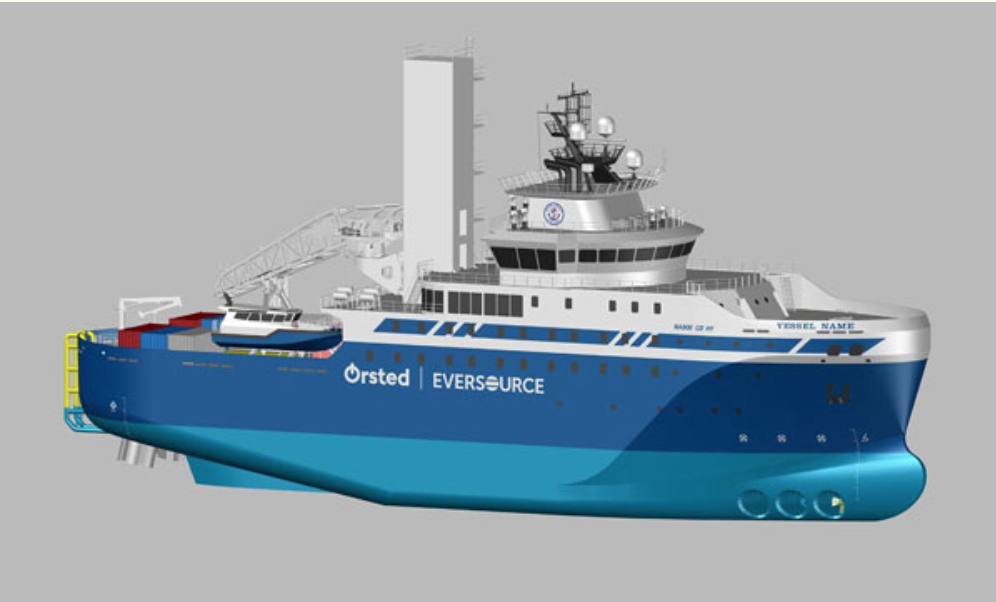Edison Chouest Offshore will build and operate the first U.S. flag, Jones Act compliant service operations vessel for the offshore wind industry, partnering with wind developers Ørsted and Eversource, the companies announced in a joint statement Oct. 1.
Under a long-term charter agreement, ECO will engineer, build and operate the vessel, to be based in New York State and perform operations and maintenance on the Revolution Wind, South Fork Wind and Sunrise Wind projects planned off southern New England and Long Island.
The development of those offshore federal leases is still contingent on obtaining all their permits from the Bureau of Ocean Energy Management, which has the processes on hold while it completes a supplemental environmental impact statement for the Vineyard Wind project. Those findings, expected to be finalized by Dec. 18, will include likely “cumulative impacts” of an expanding U.S. offshore wind industry.
But the contract for an SOV is very significant, following on the announcement in June by Dominion Energy and Ørsted that they intend to build the first U.S. flag wind turbine installation vessel for the companies’ Virginia offshore wind development. Dominion threw the switch Sept. 30 to begin sending ashore power from its pilot project, the twin turbine, 12-megawatt Coastal Virginia Offshore Wind installation 27 miles offshore.
The Edison Chouest vessel’s mission will be serving as the sea base for O&M operations after construction, carrying technicians with their tools and parts between turbine towers.
“This vessel is a special-purpose design with focus on passenger comfort and safety, enhanced maneuverability and ship motions, extended offshore endurance and reduced emissions,” according to Edison Chouest. The vessel components will be built at ECO’s shipyards in Florida, Mississippi and Louisiana, creating more than 300 new construction jobs, the company said.
Other economic effects will include ECO buying steel from North Carolina and engines built in Illinois, the company said, while stressing that the Gulf of Mexico maritime industries stand to gain from offshore skills transferable to the East Coast wind developments.
“There is an unprecedented opportunity, with twelve offshore wind projects planned, an additional ten offshore wind leases signed, and another six wind leases awaiting award. In aggregate, there is a pipeline of well over 25,000 megawatts of power to be produced by over 1,700 wind turbines, across thirteen states, and in various stages of development that will require an incredible array of vessels, resources, knowledge, and capital commitment to install, operate, and repair,” said Edison Chouest president Gary Chouest.
“We’re unique in the U.S. offshore marine vessel industry with our own in-house engineering group, our own shipyards, and a wealth of expertise in the offshore industry putting us in a dominant position in the industry with the unique capability to engineer, construct and operate specialized vessels for this market,” said Chouest.
As now designed the 260’ vessel will carry up to 60 passengers, with staterooms with private bathrooms. Amenities will include an exercise room, cinema that also serves as a training room, an internet café and multiple lounges.
A below deck warehouse will have palletized storage for tools, supplies, parts and spares, and step-less access to an elevator. A ‘daughter craft’ crew transfer vessel will be carried on board with its own launch and recovery system, and a wave height-compensating landing platform.
Like other wind developers in the U.S. and Europe, Ørsted and Eversource are looking to reduce the environmental impact of their future fleets, and the ECO vessel will run on diesel electric power meeting the EPA Tier 4 emission standards, featuring the builders’ proprietary ECO Variable Frequency Drive to reduce greenhouse gas emissions.
“This is an incredible moment for the American offshore wind industry,” said Thomas Brostrøm, CEO of Ørsted North America, Offshore. “It is hard to state what this moment means for this new, multi- billion-dollar industry. The SOV is not only a crucial part of our plans to build out and operate our Northeast Wind Farms, but it represents just how far reaching the economic impacts of offshore wind can be; offshore wind means massive investments for U.S. companies and jobs for American workers, even those in states without active projects.”
“Today’s news represents a key moment in the advancement of the offshore wind industry in the United States,” said Joe Nolan, executive vice president at Eversource Energy. “Not only is this new vessel a critical component of our plans to build and develop the next generation of clean energy in our country, it’s a testament to how far the industry has come in such a short time and what we can achieve moving forward.
Aaron Smith, president of the Offshore Marine Service Association, said the ECO contract is a milestone: “This is proof that the offshore wind will be an economic driver for the U.S. maritime industry and the U.S. maritime industry is fully capable of satisfying the needs of the offshore wind.”





